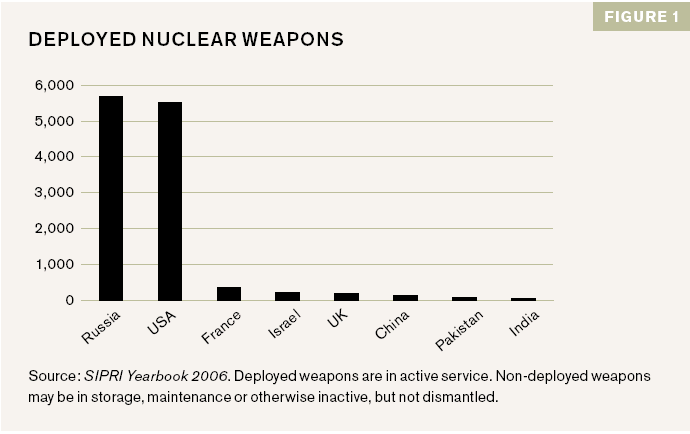A world still on the nuclear brink

Figure from Weapons Of Terror: Freeing the World of Nuclear, Biological and Chemical Arms, Report of the Weapons of Mass Destruction Commission, p.36.
Andrew Lichterman
“So long as any state has nuclear weapons, others will want them. So long as any such weapons remain, there is a risk that they will one day be used, by design or accident. And any such use would be catastrophic. The accumulated threat posed by the estimated 27,000 nuclear weapons, in Russia, the United States and the other NPT nuclear-weapon states, merits worldwide concern. However, especially in these five states the view is common that nuclear weapons from the first wave of proliferation somehow are tolerable, while such weapons in the hands of additional states are viewed as dangerous.” Weapons Of Terror: Freeing the World of Nuclear, Biological and Chemical Arms, p.60.
As noted in the previous entry, the Weapons of Mass Destruction Commission, chaired by Hans Blix, released its report, Weapons Of Terror: Freeing the World of Nuclear, Biological and Chemical Arms, at a press conference at the United Nations Thursday (download the full report in pdf here). The Washington Post online ran a Reuters story on the report predictably tracking mainstream Washington’s obsessions and repressions, focusing on Iran (who has no nuclear weapons) and its relationship to Israel (who does). The immense nuclear arsenals of the U.S. and Russia, and those of the other original nuclear weapons states, are an afterthought, relegated to a few paragraphs at the end.
A good place to start in turning this skewed world view right side up is by remembering that nuclear weapons are the true “weapons of mass destruction.” And it is worth contemplating the magnitude of the danger presented by the arsenals of the existing nuclear powers, still big enough to destroy most, perhaps all, of human civilization in a day.
A single U.S. ballistic missile submarine, armed with 12 Trident missiles each capable of carrying up to eight separate nuclear warheads, can deliver as many as 192 nuclear weapons in short order. Independent analysts estimate that the average missile load today is 6 warheads, which means 144 warheads on a single boat. Each of these weapons will have a yield of either 100 or 475 kilotons, depending on which of the two SLBM warheads are employed. The yield of the bomb the United States dropped on Hiroshima was, by comparison, estimated to be at most 15 kilotons– so these modern warheads range from more than 6 to almost 32 times the size of that first city-destroying weapon.
